 Tank of the Month
Tank of the Month
Tank of the Month
Luca Girlando's (lucasabao) Reef Aquarium
 |
Introduction
My name is Luca Girlando and I live north of Italy near a city called Modena. Maybe you've heard of it because Modena is world famous for the production of the Ferrari supercar. Unfortunately, I don’t drive one of these!
Less then one year ago I was translating an article for my great friend and reef teacher, Nando D’Amora (Nando Italy). Nando's jewel had been selected for TOTM in January 2010. Please forgive me if I call his aquarium “jewel” but in my opinion it remains the prototype of a SPS tank. At the time, I dreamt about my tank also being selected as TOTM one day. I had absolutely no idea that just 10 months later it would be my turn. Therefore I thank ReefCentral and I’m honoured to present my little….. well, maybe not so little piece of reef!
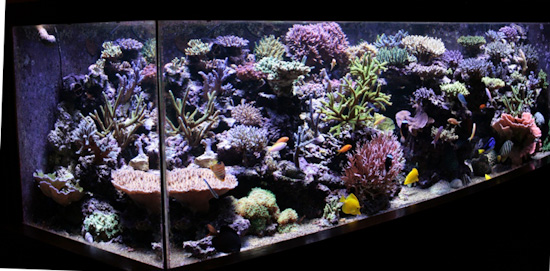 |
Background
My story starts, as for most of us, with my granddad buying me my first 2 little goldfish.
I was seven at that time. Now I own and run a goldfish farm and my job is breeding them in their millions! After the goldfish came several freshwater tropical aquariums. I then moved on to establishing my first saltwater aquarium more than 20 years ago. I can still remember it very well. It was 60 litres (16 US gallons) with a biological filter and a very basic skimmer, 2x T8 neon tubes and the inside was home to a Hippo tang, a couple of mushrooms and a bubble coral. Since that day I have always had at least one marine tank running wherever I was living until the time came to buy my own house, which obviously has been chosen in consideration of the tank; the marine aquarium I have dreamt about for 20 years!
To be completely honest, in the end, I didn’t achieve exactly what my dreams were but let’s just say that I am quiet satisfied.
Project and System Profile
I’m not exaggerating by telling you that my house has been build around my tank. I had the luck of buying my new home while it was still under construction. Once I had decided on the location of the tank in the living room, I planned all the pipework so that it would be running under the floor and in the walls. I even planned the electrical outlets properly too. In the planning I constructed a chimney right above the aquarium which houses an extractor fan to reduce humidity and also heat generated by my lighting system. This measure was necessary as the aquarium was designed to be built-in meaning that the area above the tank was enclosed.
 |
The tank itself has an unusual shape; its 230cm long and 70cm high (90.6in x 27.6in). The front to back measures 100cm on the wide side and 70cm on the narrow side with a slightly curved 19mm thick front glass (27.6in to 39.4in). The total capacity of the display is 1370 litres (362.6 US gallons). The overflow box hides two 63mm overflow pipes, one of which goes directly into the sump. The other overflow ends in a secondary tank, where in the past has been used as refugium, and also where a lot of detritus settles on the bottom that can be easily siphoned during water changes. From this secondary tank the water drains into the sump. At the back of the sump there is a compartment with a volume of 120 litres (31.7 US gallons) and a overflow that leads directly to the drain in order to prevent flooding (no more wet floors was the agreement with my wife). This compartment has an additional function: to contain my RO water for evaporation replenishment and to contain the exact amount of water to drain for water changes. Inside there is a length of pipe cut at the correct level to discharge 120 litres of dirty aquarium water directly into the waste drain. No more wet floors for my wife if you remember! The RO water is produced in a different room and carried there via a pipe built into the wall. When I want to change the water in my tank, all I need to do is open a valve. I only need to fill the compartment the day before the water change with RO water, turn off the osmoregulator, add the correct amount of salt and turn on a little pump to dissolve it. The day after, once discharged the old water from the tank, I only need to pump the new water from the compartment into the sump, fill it up again with RO water and turn the osmoregulator on again.
 |
For my chiller I have drilled two 40mm holes and placed bulkheads in my sump. I connected them to a double pipe running under the floor of my house towards the back garden where an external pump pushes the water through the chiller. The water returns back to the display tank by again running under the floor. I also have a second smaller return pump in the sump as I believe in strong water exchange. I keep turnover at least 5-6 times the whole system volume per hour between the sump and the display tank.
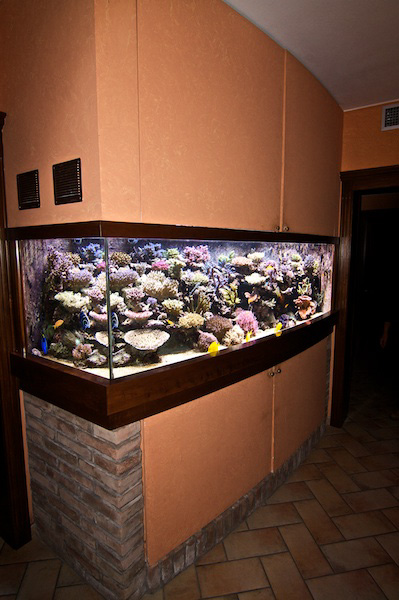 |
System Profile
• Display tank: 230 x 70 x 70-100cm 1370 litres (90.6" x 27.6" x 27.6" to 39.4" ~363 US gallons)
• Sump: 300 litres (water amount is approx. 80 US gallons)
• Skimmer: Bubble King 300 Internal
• Lighting: Aqualiving LED (360 white and 160 blue on PLC dimmable controller)
• Circulation: 7x Tunze 6055 Nano Streams, 1x Tunze 6125 Turbelle, Tunze 7095 Multicontroller
• Return Pump: 2 Newa New Jet 6000
• Calcium Reactor: LGR 2500
• Zeolite Reactor: Korallenzucht Medium fed by aquabee UP 2000 pump
• Chiller: Aquamedic Titan 2000
• Ozone: Aquamedic ozone 300
Filtration
We call it filtration but in fact it would be more accurate to call it water treatment as the most efficient and useful filtration is made by the live rock. As I have already suggested I believe in a strong exchange between sump and display tank, at least 5-6 times the whole volume of the tank is very helpful for the overall health and vitality of my system. Therefore I’ve installed two return pumps in order to achieve approx 8000 litres/hour real flow from sump to display. Part of the display water flows empties to the sump directly and part of it flows through a settling tank, which was previously my refugium, where the particulate matter settles out effectively. From here I regularly siphon the detritus from there during my regular water changes.
 |
In the sump is housed the real heart of the whole system: a Bubble King 300 internal skimmer that is an expensive piece of equipment but worth the money. Without that skimmer I believe that it would not be possible to keep all the fish that I have and keep my corals with acceptable colours. In the past, I have connected the venturi to a 300mg/hour adjustable ozonizer that I dosed at roughly 150 mg/hour for 8 hours at night. Recently, I haven’t used it and it appears that I do not need it anymore.
I also use 4 litres of zeolite in a Zeolite reactor that is fed by an aquabee UP2000 pump which has a real flow of approx 1600 litres/hour (420 US gallons/hr). I shake the zeolite very often, at least 3-4 times a day, and usually give it 30 shakes at a time. The zeolite media is changed completely every 6 weeks. In my opinion it’s very important for the correct function of the zeolite to shake it often and to skim very wet. In fact, I produce about 5 litres of “pils beer” coloured skimmate every day. In addition to the zeolite I dose 0,5ml of Zeostart twice a day.
However, I guess most of the dirty work within my aquarium is conducted by the 350kg of liverock present in the main display.
Lighting
First of all I must give you some background information. Up to June 2010 I had 4 Giesemann Spectra 400W metal halides run by electronic ballasts and 4 x 24W T5s for each unit with an additional unit containing 4 x 54W T5s at the wide end of the aquarium. Then with the continuous increase in the cost of electricity and the interesting developments with LED light technologies I made the big decision: let’s try LED! At first I swapped a Spectra with an equally sized LED lamp from an Italian company called Aqualiving. After trying it for several months I eventually made the switch with my entire display tank. At this point I’m very happy with my custom built Aqualiving pendant. It is composed of 360 white LEDs and 160 blue LEDs that are separately dimmable through a PLC controller. I currently have the LEDs set for 100% power for white and 70% for blue as I like more warm lights. Though I know many friends of mine that have the opposite view and like the cool look that is similar to Radium metal halide bulbs.
 |
The amazing thing about LEDs on a tank this size is that I have reduced my electricity consumption from 2500W to 900W. With it comes no more heat problems as all the heat is generated on the upper side of the lighting units which is removed using the extractor fan. Virtually no heat is being emitted from the underside at all. Due to the lower electricity consumption, I have increased the photoperiod to 12 hours with the blue LEDs starting 15 minutes before and after the white LEDs photoperiod.
Water Movement
For me and I guess for most aquarists this has been a huge issue for a long time. In my case the unusual shape of the tank didn’t help with water movement. After innumerable different pumps and attempts I finally found a satisfying compromise. I now use 7 x Tunze Nanostream 6055 and one big Tunze Turbelle 6125. Each Nanostream is connected to my Tunze 9075 Multicontroller and run in pulse mode. During the night I reduce their power to run at 30% of their potential while the big Turbelle doesn’t run at all. All of the Nanostreams, except for one which is positioned on the corner of the overflow box, are fitted into the rockwork located at the back of the tank. These are all aimed to have flow in the direction of the front glass and the big Tunze 6125 is positioned on the side of the aquarium with the flow going diagonally towards the opposite end.
Maintenance, Feeding and Additions
Running a big SPS dominated reef tank with many fish surely requires a big effort. However, at the end of the day my husbandry is quiet simple. I shake the zeolite, clean the skimmer and change some water. Easy, isn’t it? OK, not as easy as it sounds but its nothing that is impossible to do. I've already explained the importance of shaking the zeolite often, 3 to 4 times each day for about 30 shakes each time, so won't go into detail again.
As with all skimmers it is very important to keep the foam collection funnel as clean as possible in order to maximise the potential of the skimmer. I generally clean the funnel every second day and sometimes every day.
The other crucial thing I do for maintenance is regular water changes. I change 120 litres every week. At the moment I prepare the water using Tropic Marine Bio Active salt but I have also used Aquamedic Reef Salt and Crystal Sea Marinemix with good results. Also, I think it’s not a bad idea to change your salt brand occasionally just to ensure that you do not get a shortage of any non-measurable elements.
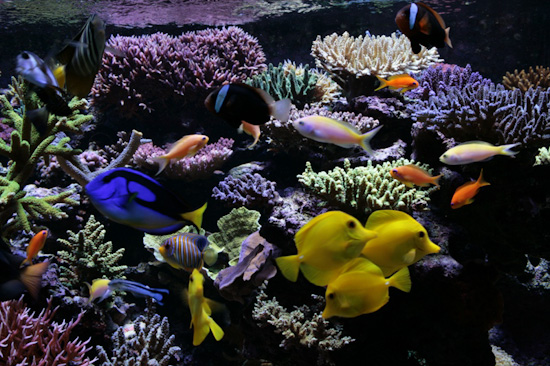 |
After each water change I add 2 vials of Prodibio Biodigest and 4 vials of Prodibio Bioptim. Other addition I currently supplement with now:
- Once a week on alternate days I add half the recommended dose of Prolabmarine's boron, fluorine and potassium.
- Twice a week I dose Brightwell Aquatics KoralColor.
- Daily I add Prolabmarine's magnesium in order to keep the magnesium level high.
- During periods where I dose ozone, I will also supplement with 10 drops of Kent tech I daily.
- Calcium and alkalinity are maintained in the correct range by a LGR 2500 Calcium reactor filled with 30kg of jumbo size coral gravel that I have to replace every 6-8 months.
- The last thing I add to the aquarium are 2 drops every night of Korallenzucht Amino Acids.
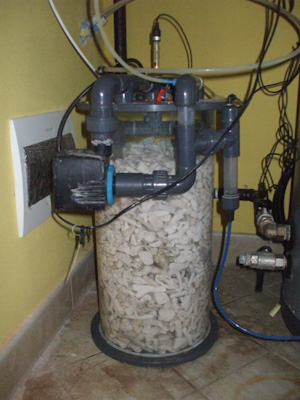 |
Other than those supplements I don’t feed my corals, they don’t need it! My experience has been that if there are enough fish in the aquarium that are fed regularly, together with the bacterioplankton shaken off the zeolite, they will provide enough heterotrophic food for SPS corals. Of course this is in addition to providing enough light. I feed my fish once a day using mostly crumbles of Spirulina Flakes. Only once a week I feed them freeze dried artemia soaked in a multivitamin solution.
|
Water Parameters:
|
 |
Live Stock
|
Fish:
|
 |
 |
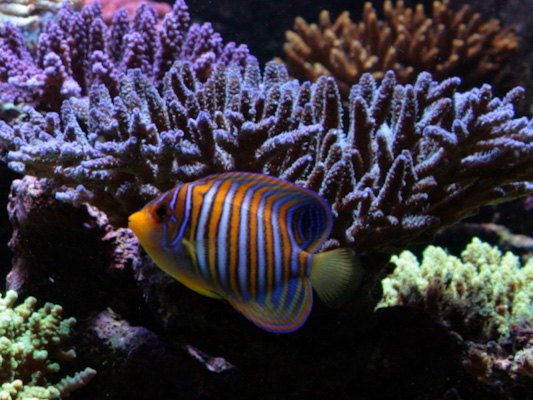 |
 |
 |
 |
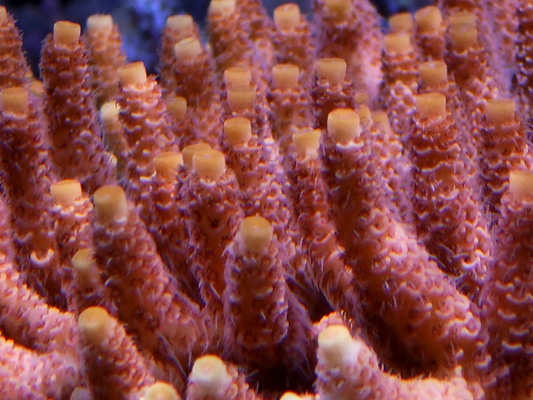 |
Acknowledgements
I could easily write an immense list to thank everybody involved with my tank but I will keep it short due to space constraints and I apologise in advance to everyone who has helped and inspired me. First of all, my biggest thanks must obviously go to my wife Isabella, her patience and support have no limits. It must be incredibly difficult for a normal person to live in the same house as a crazy man who comes back from work and checks on the corals even before saying hello! Second, a special thank you to my great friend Chris from the UK who flew over to Modena for a week to help me initially setup the aquarium and who corrected the thousands of errors I made in writing this article. Also, thanks to all my friends on the Italian reef keeping forum www.reefitalia.net for their infinite suggestions and the innumerable discussions about different areas of our hobby. Surely a very important influence for my growth as reef keeper. Finally, I want to thank everyone who nominated me for TOTM in ReefKeeping Magazine.
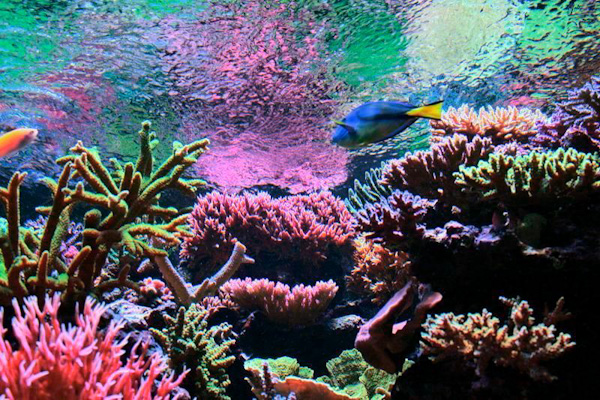 |
Feel free to comment or ask questions about my tank in the Tank of the Month thread on Reef Central.



